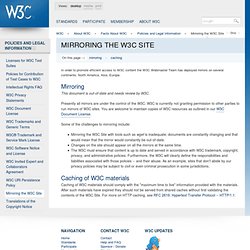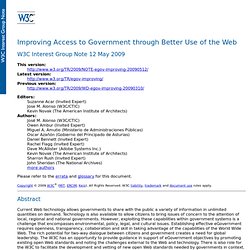

The free dictionary. Fichecorp07anglaisweb.pdf (application/pdf Object) 80legs - Custom Web Crawlers, Powerful Web Crawling, and Data Extraction. World Wide Web Consortium (W3C) Mirroring the W3C Site. In order to promote efficient access to W3C content the W3C Webmaster Team has deployed mirrors on several continents: North America, Asia, Europe.

Mirroring This document is out-of-date and needs review by W3C. Presently all mirrors are under the control of the W3C. W3C is currently not granting permission to other parties to run mirrors of W3C sites. You are welcome to maintain copies of W3C resources as outlined in our W3C Document License. Some of the challenges to mirroring include: Mirroring the W3C Site with tools such as wget is inadequate: documents are constantly changing and that would mean that the mirror would constantly be out-of-date.Changes on the site should appear on all the mirrors at the same time.The W3C must ensure that content is up to date and served in accordance with W3C trademark, copyright, privacy, and administrative policies.
Caching of W3C materials Caching of W3C materials should comply with the "maximum time to live" information provided with the materials. Improving Access to Government through Better Use of the Web. Abstract Current Web technology allows governments to share with the public a variety of information in unlimited quantities on demand.

Technology is also available to allow citizens to bring issues of concern to the attention of local, regional and national governments. However, exploiting these capabilities within government systems is a challenge that encompasses environmental, policy, legal, and cultural issues. Establishing effective eGovernment requires openness, transparency, collaboration and skill in taking advantage of the capabilities of the World Wide Web. The rich potential for two-way dialogue between citizens and government creates a need for global leadership. This document is an attempt to describe, but not yet solve, the variety of issues and challenges faced by governments in their efforts to apply 21st century capabilities to eGovernment initiatives. Status of this document This section describes the status of this document at the time of its publication.
Better Government Through Better Use of the Web. C Technology & Society Domain. Working at the intersection of Web technology and public policy, the Technology and Society Domain's goal is to augment existing Web infrastructure with building blocks that assist in addressing critical public policy issues affecting the Web.

Our expectation is not to solve policy problems entirely with technology, but we do believe that well-designed technical tools can lead to policy approaches that are more consistent with the way the Web should operate. The Semantic Web is an important component in this endeavor, as it provides the means for various entities to instrument their interactions through formal specifications of vocabularies describing relevant policies, rules and resources.
Semantic Web technologies will enable our machines to assist users in exercising more control over their online environment and interactions. DIG Current Projects. Decentralized Information Group. Web 3.0. Just in case you missed it, the web now has version numbers.

Nearly three years ago, amid continued hand-wringing over the dot-com crash, a man named Dale Dougherty dreamed up something called Web 2.0, and the idea soon took on a life of its own. In the beginning, it was little more than a rallying cry, a belief that the Internet would rise again. But as Dougherty's O'Reilly Media put together the first Web 2.0 Conference in late 2005, the term seemed to trumpet a particular kind of online revolution, a World Wide Web of the people. Web 2.0 came to describe almost any site, service, or technology that promoted sharing and collaboration right down to the Net's grass roots.
That includes blogs and wikis, tags and RSS feeds, del.icio.us and Flickr, MySpace and YouTube. Which raises the question: What will Web 3.0 look like? Yes, it's too early to say for sure. But some are skeptical about whether the Semantic Web—or at least, Berners-Lee's view of it—will actually take hold.